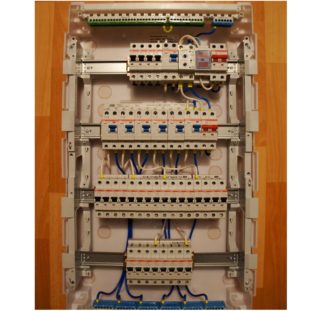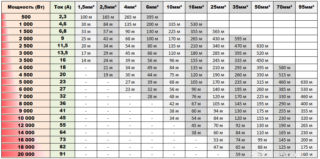Electrical wiring in a private house or apartment needs protection against possible overloads and current leakage. To install the devices with your own hands, you need a circuit for connecting RCDs and machines.
Basic principles of connection
The main requirement - the installation of RCDs and machines must be performed correctly. The uninterrupted operation of household appliances, the safety of the home and those living in it depend on this. To protect home appliances from short circuits and power surges, and residents from electric shock, protective devices are included in the wiring diagram.
As a rule, the shield has a conventional residual current device (RCD). It only works during current leakage. Difavtomat is a device that consists of an RCD and a circuit breaker and performs two functions at once. It protects the system during a short circuit or overload, and also works when a current leakage in the network.
RCD selection by main parameters
It is important not to make a mistake with the choice of device. Only a specialist can figure out the technical nuances of an RCD. Therefore, the selection is performed immediately during the development of project documentation.
Existing types of RCD
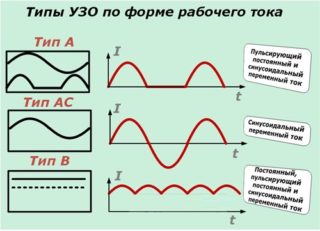 In the circuit, in accordance with the types of currents, there can be RCDs of different classes. Speaker type is used in residential premises, as it is cheaper than modern analogs. It is designed for ac sinusoidal current. Most of the electrical receivers work on it. AC class enclosure is marked “~”.
In the circuit, in accordance with the types of currents, there can be RCDs of different classes. Speaker type is used in residential premises, as it is cheaper than modern analogs. It is designed for ac sinusoidal current. Most of the electrical receivers work on it. AC class enclosure is marked “~”.
Type A also detects a leakage of a constant ripple current. The number of consumers of pulsed DC is constantly growing. Therefore, instead of old devices, they choose more reliable Class A devices. They cost 20-30% more.
A Type B instrument detects a leakage of a constant, rectified ripple and sinusoidal current. But in a private house or apartment they are not used. Such devices are used in industrial enterprises.
The nuances of selecting the device
When choosing an apparatus, the main criterion is the rated current that passes through it during continuous operation. This value (In) can vary from 6 to 125 A.
The second important protection parameter is the fixed value of the differential current (IDn). For selection, the series includes the following values: 10, 30, 100, 300, 500 mA and 1A. The RCD is triggered when the selected value is reached.
Also, the selection depends on the purpose of the installation. Priority is recommended to give safety requirements. For this, the device must be oriented to a certain value of the rated current with some margin. If an RCD is necessary for a private house or apartment, all available loads are summarized.
Installation of UZO and automatic machines in a guard
Laying the cable and wiring is half the battle. The main task is the installation of a distribution panel. It houses a metering and load balancing device. And also this place for installation of residual current circuit breakers and circuit breakers. These devices are designed to eliminate possible malfunctions in the network:
- short circuit that occurs when the load resistance decreases to the minimum values;
- wire overload with powerful devices, which causes overheating of current-carrying conductors, and insulation loses dielectric properties;
- violation of insulation leads to leakage of currents through a random circuit to earth.
Protective shutdown is one of the most important elements of the entire system, ensuring safety. To install an RCD and automatic machines, you will need a circuit and a minimum set of tools. You also need a cable of a certain section - VVG of different colors. For marking conductors, use an PVC insulating tube.
If a person touches the conductive parts of the wiring, the device detects a current leak and instantly breaks the power circuit
How to connect an RCD in the shield
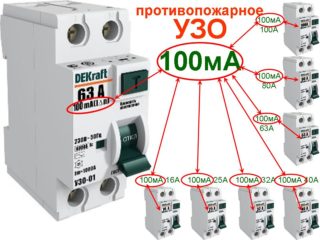 To control current leakage, a device with a sensitivity of 100 mA is required. If the length of the wiring is small, there will be no false positives with an RCD of 30 mA. When connecting, a certain rule must be observed, regardless of the selected electrical circuit. In series with the device, you must connect the machine.
To control current leakage, a device with a sensitivity of 100 mA is required. If the length of the wiring is small, there will be no false positives with an RCD of 30 mA. When connecting, a certain rule must be observed, regardless of the selected electrical circuit. In series with the device, you must connect the machine.
RCDs are not protection against short circuit and overload. If they occur, the device will fail. The contacts of the device stick, the circuit where the short circuit occurred is under voltage. The wire continues to heat up, possibly igniting the insulation.
In order to de-energize the device, and it did not fail, an automatic machine with a rated current less than one or two orders of magnitude RCD must be installed in front of it. For example, an RCD of 63 A is suitable for an RCD at 63 A.
To save money through one RCD in a switchboard, several groups of consumers are connected at once. The more circuit breakers, the higher the cost of installing the shield. It is important to know how many machines can be connected to one RCD on 40a. According to the rules, more than two machines cannot be connected to one device. Moreover, their total load capacity should be no more than the RCD rating.
If you plan to connect several protection devices paired with a circuit breaker, it is advisable to replace them with a differential circuit breaker.
Only the correct connection of the RCD in the shield will protect the electrical system and equipment, whether it be a house, a garage or a summer residence.
Features of connection schemes
Practice shows that the circuit of an electrical panel in an apartment with an RCD, even drawn by hand, greatly simplifies and speeds up installation work. In addition, the saved document may be needed during the repair or in order to connect additional devices to the electrical panel. Manufacturers of powerful household appliances - electric stoves, boilers, dishwashers or washing machines - in the accompanying documentation indicate the need to install additional protective devices.
The circuit of the general RCD in a single-phase circuit with grounding consists of an electric meter common to all groups of the residual current device and circuit breakers for a single group of consumers. Such a sequence can be used if the network is not very extensive, has a minimum number of consumers, for example, for a two-room apartment.
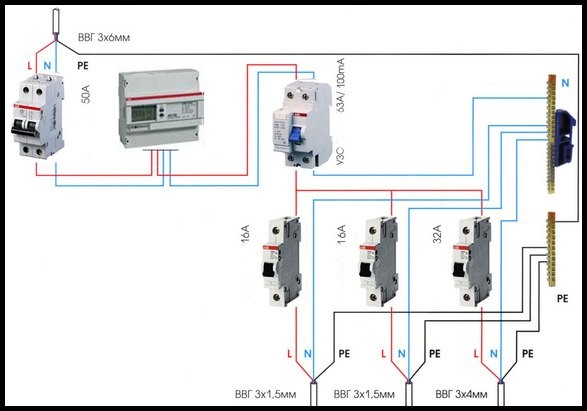
The phase wire from the output of the counter is connected to the left contact of the RCD, and zero to the right. The phase exiting the protective device diverges to the circuit breakers of all groups. The zero wire, through a common bus goes to the zeros of electrical consumers.
The advantages of such a scheme are simplicity. For installation, a small shield and minimal costs for the purchase of one RCD are suitable. The negative side - false positives will occur at high loads, since there is always a current leakage in the circuit.
A circuit with several RCDs in a single-phase network provides for the installation of a device for each group. In this case, the phase coming from the counter is connected to the upper contact of each device. The phase wire emerging from each device must be connected to the circuit breaker of the group that the RCD will power. Outgoing zeros are connected via separate buses to their groups.
Zero wires from different devices should not be interconnected.
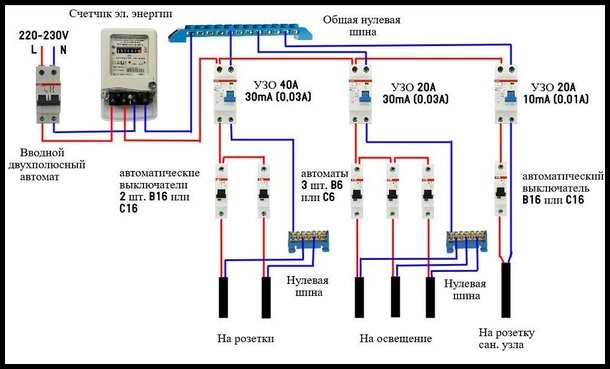
In the event of a current leak, a certain group of consumers or part of it is switched off, only one that is powered by a specific RCD. The implementation of such a scheme will require additional financial investments.
RCD connection to a three-phase network
Such a network may consist of three phase conductors, neutral and protective earth wires. The voltage between the phases is 380 V, between the phase and zero 220 V. It is important to correctly carry out the load distribution. If one of the phases is loaded more than the other, a skew occurs, as a result, an emergency can occur.
The connection is performed in the same way as in a single-phase circuit. A four-pole device is installed at the input or one device per load group. A counter is placed between the input circuit breaker and the residual current circuit breaker.
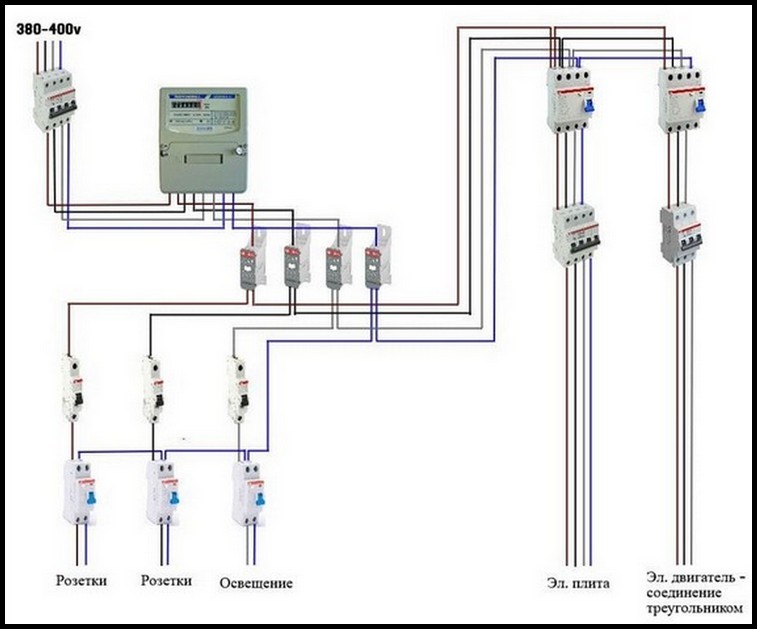
Three phases supply electricity for equipment rated at 380 V. A single phase with a zero conductor supplies single-phase consumers. Connection is made through circuit breakers. If conditions allow, it is better to use separate devices for lighting, sockets and a washing machine.
Three-phase network is rarely used in apartments. Such wiring is appropriate in a private house, for connecting a pump, compressor, concrete mixer, lathe or welding unit.
Option to connect machines without an RCD
If the network is simple and there is no need to connect machines to separate consumer groups, instead of an RCD at the input after the meter, it is better to put a difavtomat. In emergency conditions, the device switches off both phase and zero. Shutdown occurs both with a short circuit and with a leakage of currents.

In fact, these are two devices in one case - an RCD and a circuit breaker. The advantage of the device is that the wiring is safe. The connection is simplified, and in the shield it takes up less space.
The disadvantage is that some models do not have the necessary notation. If the device trips, it is impossible to determine the cause - a short circuit or current leakage has occurred. If one part of the device becomes unusable, the entire difavtomat will have to be replaced. And this is an additional cost.
Such a device can be successfully connected at the cottage, where there are several outlets for simple household appliances and light bulbs for lighting. Differential protection can also be installed on a powerful consumer, especially in conditions of high humidity. This is street lighting, a line going to the basement, a bathhouse. The machine can be both with grounding, and without. If the electric shield is metal, its case must be grounded.
It must be taken into account: in order for only one phase to turn off, the difavtomat must be bipolar.
RCD and machines on a three-phase switchboard
To connect to a three-phase circuit, permission is required. Three-phase shield is more complicated than single-phase. It comes to zero, protective earth and 3 phases. Such a device makes it possible to obtain 380 V from the power supply organization and connect large loads. However, this is an additional cost and the need for proper distribution of electricity.
The main task of the three-phase shield is to distribute the load evenly. You can not connect all home appliances to one phase, so that the other two remain redundant. Then in this phase the voltage will be low, and in others it will rise by several volts. You can protect yourself from troubles by setting the phase switch.

The choice of scheme involves taking into account the features of the electrical network. A network of this type includes a three-phase RCD with eight contacts, or three single-phase devices. Installation is carried out according to the established scheme.
Three-phase tripping devices are adapted to large current leaks and protect the wiring only from fire. But most household consumers need a single-phase network. Powerful hobs, water heaters, boilers are connected to the three-phase one.
Errors in connecting an RCD
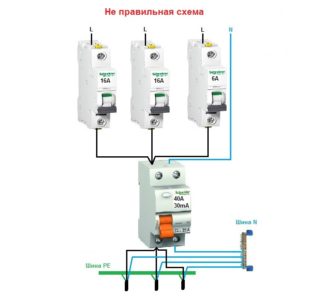 It is not always possible to use the services of a specialist. Sometimes devices have to be installed independently. Before connecting, check the technical specifications of the device again. All values are determined by the marking on the device. The rated current of the RCD must be higher than that of the input machine.
It is not always possible to use the services of a specialist. Sometimes devices have to be installed independently. Before connecting, check the technical specifications of the device again. All values are determined by the marking on the device. The rated current of the RCD must be higher than that of the input machine.
For ground and neutral conductors must have their own busbars. Do not confuse phase and zero. Their poles have their own designations (L and N), and the conductors differ in color. Examples of errors that occur most often:
- neutral phase and ground connection after RCD;
- out-of-phase connection of the device;
- improper connection of conductors in the outlet (zero and ground);
- connection of zeros from two RCDs;
- mixed phase and zero in different protection devices;
- non-observance of polarity during installation;
- installation errors of a three-phase RCD.
Correctly drawn up diagram of a one- or three-phase network, skillfully completed wiring installation will provide reliable protection against electric shock and fire.
